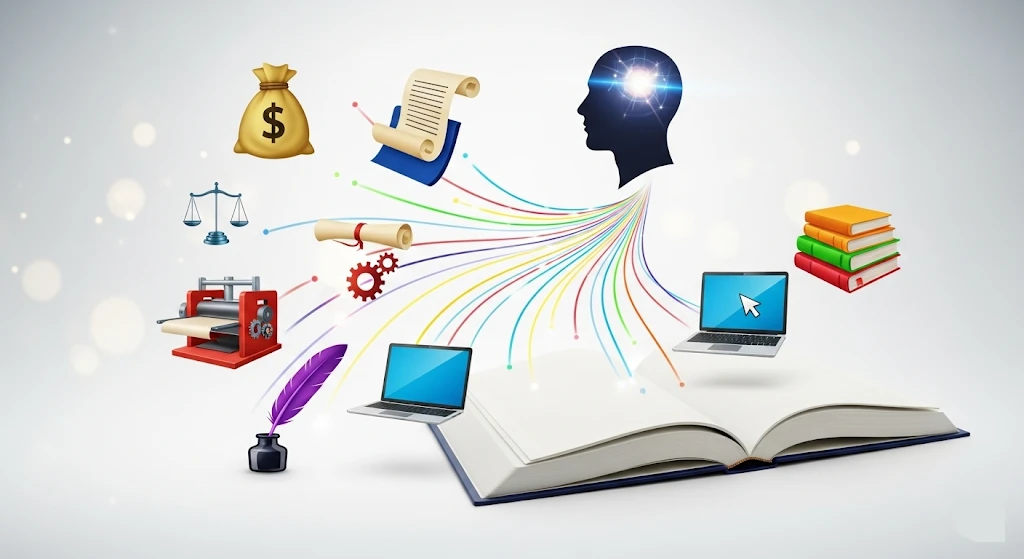Have you ever wondered how a book goes from an author’s mind to your favorite bookstore’s shelf? The business of book publishing can seem like a maze, especially for aspiring authors and curious readers alike. This post will guide you through the intricate process of book publishing, from writing and editing to marketing and distribution. Whether you’re an author looking to get published or a book lover wanting to understand the industry, this blog will provide valuable insights into every step of the publishing process.

Understanding Book Publishing
What is Book Publishing?
Book publishing involves the production and dissemination of literature or information—the activity of making information available for public view. Traditionally, the term refers to the distribution of printed works such as books and newspapers. However, in the digital age, publishing includes electronic versions of books (eBooks) and digital platforms.
Types of Publishing
There are several types of publishing models available today:
- Traditional Publishing: This involves a contract where the publisher buys the rights to publish your book and pays you an advance and royalties.
- Self-Publishing: Authors take on the role of the publisher and are responsible for all aspects of the book’s production and distribution.
- Hybrid Publishing: Combines elements of traditional and self-publishing. Authors may pay up-front costs but retain higher royalties.
Artificial intelligence is rapidly reshaping publishing by streamlining workflows, enhancing creativity, and offering innovative tools for authors and publishers to revolutionize the book publishing industry.
The Role of Literary Agents
Literary agents act as intermediaries between authors and publishers. They help authors refine their manuscripts, negotiate contracts, and secure deals with publishing houses. Agents are critical in traditional publishing, as many publishers do not accept unsolicited manuscripts.
The Manuscript Process
The first step in publishing is writing. Authors pour their ideas, creativity, and hard work into creating a manuscript. This can be a long and challenging process, taking anywhere from months to years. Once the manuscript is complete, it undergoes several rounds of editing. This includes developmental editing (big-picture changes), copyediting (grammar and style), and proofreading (final polish). Professional editors play a significant role in ensuring the manuscript is the best it can be. For traditional publishing, authors (often through their agents) submit a query letter and manuscript sample to publishers. The goal is to catch the attention of an acquisition editor who believes in the book’s potential.
The Publishing House
If a publisher likes the manuscript, they acquire the rights to publish it. The acquisition process includes contract negotiations, where terms like advance payments and royalty rates are agreed upon. After acquisition, the manuscript moves to the design phase. This includes cover design, which is crucial for marketing, and typesetting, which ensures the text is laid out correctly for printing. Once the design is final, the book goes into production. Traditional publishers print physical copies, while self-published authors may use print-on-demand services to manage costs.
Marketing and Sales
Marketing is essential for a book’s success. Strategies include book tours, social media campaigns, and book reviews. Publishers often have marketing teams, while self-published authors handle their own promotion. Books are distributed through various channels, including bookstores, online retailers, and libraries. Digital platforms like Amazon Kindle and Apple Books have expanded the reach of eBooks. Authors earn royalties based on book sales. Traditional publishing offers lower royalties but wider distribution, while self-publishing offers higher royalties but requires more effort in marketing and distribution.
AI Publishing
The integration of AI into publishing is a growing trend that promises to reshape the industry landscape. Artificial intelligence is Transforming the Publishing Industry in unprecedented ways. AI tools can assist with various tasks, from content generation to market analysis. For instance, AI algorithms can analyze reader preferences and suggest plot elements or titles that are likely to be successful. Additionally, AI can streamline the editing process by identifying grammatical errors and suggesting improvements. This technology not only accelerates the publishing timeline but also enhances the quality of the final product.
Challenges in Publishing

The publishing industry is highly competitive. Thousands of books are published every day, making it challenging for new titles to stand out. Effective marketing and a unique selling proposition are crucial for success. Publishing involves significant financial risks. Traditional publishers invest in advances, production, and marketing with no guarantee of success. Self-published authors bear these costs themselves, risking their own money. Consumer preferences are constantly evolving. Trends like the rise of eBooks and audiobooks require publishers to adapt their strategies. Staying attuned to market trends is essential for long-term success.
Understanding the business of book publishing is essential for anyone looking to enter the industry or simply interested in how their favorite books come to life. From writing and editing to marketing and sales, each step involves careful planning and execution. The rise of AI in publishing offers exciting possibilities for the future, making the process more efficient and accessible.


